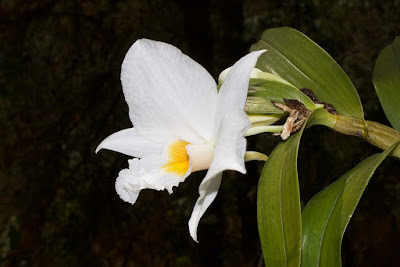Dendrobium infundibulum is widespread in Southeast Asia. Natural habitats include north-eastern India, Myanmar, Thailand, Cambodia, Laos and Vietnam. They usually grow in deciduous or semi-deciduous forests, at heights of 1000-2300 m.
Dendrobium infundibulum, also called as The Small-Funneled Lip Dendrobium, Callista infundibulum, Dendrobium jamesianum, Dendrobium moulmeinense, is a species of the genus Dendrobium. This species was described by Lindley in 1859.
IDENTIFY DENDROBIUM INFUNDIBULUM
Dendrobium infundibulum is widespread in Southeast Asia. Natural habitats include north-eastern India, Myanmar, Thailand, Cambodia, Laos and Vietnam. They usually grow in deciduous or semi-deciduous forests, at heights of 1000-2300 m. In some locations they can be found at an altitude of only 200 m.
It is a medium to large sized, hot to cool growing epiphytic species, which can reach the height 30-100 cm, with erect, cylindrical, to 10 leafed, 30-100 cm long stem with sheaths covered with black hairs and narrowly ovate or linear-lanceolate, all along the new stem, dark green, obscurely bilobed apically, 8-13 cm long leaves.
The Small-Funneled Lip Dendrobium can bloom at almost anytime of the year but mostly in the spring and summer with an axillary, short, 2 flowered raceme that arises from the nodes near the apex of the older leafless canes. The flowers are 8-10 cm in diameter. The outer whorls and the large, round petals of the inner whorl are ivory-white. The base of the side outer petals forms a long, chimney-shaped spur. The white lip has large orange or gold-yellow spots and scarlet or yellow stripes at the base. The large central plot is undulated along the serrated edge. The Var. jamesianum has a lot of cinnabar-red spots.
DENDROBIUM INFUNDIBULUM CARE AND CULTURE
Cultural information should only be used as a guide, and should be to be adapted to suit you. Your physical location; where you grow your plants, how much time you have to devote to their care, and many other factors, will need to be taken into account. Only then can you decide on the cultural methods that best suit you and your plants.
Light:
Dendrobium infundibulum needs a light level of 25000-35000 lux and distributed light is recommended.
Temperature:
The average temperature of the summer day is 22-24 ° C, the night 15-16 ° C, and the daily difference is 7-9 ° C. In spring, the average day temperature is 26-27 ° C, night 8-15 ° C, and the daily difference is 11-18 ° C. In winter, the average day temperature is 21-24 ° C, the night 5-6 ° C, giving a daily difference of 15-18 ° C.
Humidity:
The Small-Funneled Lip Dendrobium need the average humidity of 75-80% in summer, but it drops to almost 60% in the 2 winter months.
Substrate, growing media and repotting:
Dendrobium infundibulum should be mounted on tree rootstocks or cork and we need provide high humidity and watering in summer at least once a day. They can also grow in pots, in a loose substrate that can retain moisture in the growing season.
Watering:
In summer, the precipitation is moderate to heavy and in winter it is definitely drier. Dendrobium infundibulum should be abundantly watered during active growth, but when new growths reach maturity in autumn, the amount of water should be gradually reduced.
Fertilizer:
It is recommended to use a 1/2-1/4 dose of orchid fertilizer weekly. From spring to mid summer, fertilizer with an increased nitrogen content is preferred, and fertilizer with an increased content of phosphorus should be used at the end of summer and autumn.
Rest period:
A cool, dry rest is very important for the Dendrobium infundibulum and should last until the spring appears of new increments. This species can tolerate even a few degrees below 0 ° C for a brief period, but such extreme conditions should be avoided in the cultivation. You can eliminate watering in winter, but the plants will be in better condition if they dry out between waterings for most of winter, but they will not dry for too long. However, the period of 1-2 months at the end of winter, the plants need to dry completely between waterings and stay dry longer. Occasional morning fogging between waterings will protect the plant from excessive drying. Fertilization should be significantly reduced or eliminated until spring, when more watering is undertaken.















COMMENTS